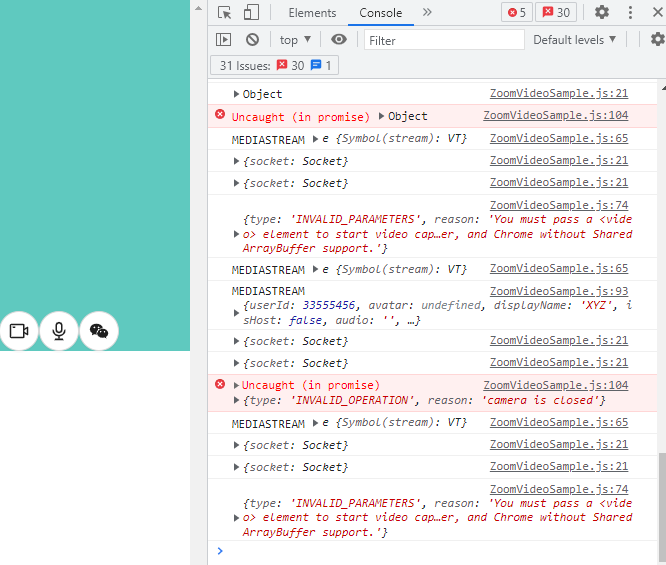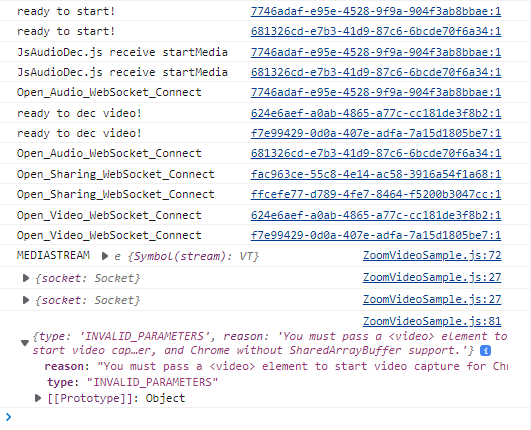Hi @rehema.zoom
I able to join the call but the problem here is i am not able to put functional video button(the video is not switching on even after starting the button)
Code
import ZoomVideo from “@zoom1234/videosdk”;
import { generateSessionToken } from “…/config/signature”;
import { Button, Tooltip } from “antd”
import React, { useEffect, useState, useCallback } from ‘react’;
import {
AudioOutlined,
AudioMutedOutlined,
VideoCameraAddOutlined,
VideoCameraOutlined,
WechatOutlined,
} from “@ant-design/icons”
// window.ZoomVideo = ZoomVideo
export default function ZoomVideoSample(socket) {
const [videoStarted, setVideoStarted] = useState(false)
const [audioStarted, setAudioStarted] = useState(false)
const [isMuted, setIsMuted] = useState(false)
const [isChat, setIsChat] = useState(false)
const [isSAB, setIsSAB] = useState(false)
const [mediaStreamVideo, setMediaStreamVideo] = useState(‘’)
console.log(socket);
const zmClient = ZoomVideo.createClient();
const sessionConfig = {
sdkKey: 'redacted',
sdkSecret: 'redacted',
topic: 'Call handle',
password: '123',
name: 'XYZ',
sessionKey: '',
user_identity: '',
role: 0
};
// console.log('zmClient1:', zmClient);
let mediaStream
const sessionToken = generateSessionToken(
sessionConfig.sdkKey,
sessionConfig.sdkSecret,
sessionConfig.topic,
sessionConfig.password,
sessionConfig.sessionKey,
sessionConfig.user_identity,
sessionConfig.role
);
const createOne = () => {
// const zmClient = ZoomVideo.createClient();
zmClient.init('US-en', 'CDN')
zmClient.join(sessionConfig.topic, sessionToken, sessionConfig.name, sessionConfig.password).then(() => {
mediaStream = zmClient.getMediaStream()
// mediaStream.startVideo()
setMediaStreamVideo(mediaStream = zmClient.getMediaStream())
console.log('YES', mediaStream);
}).catch((error) => {
console.log(error)
})
}
const isSupportWebCodecs = () => {
return typeof window.MediaStreamTrackProcessor === "function"
}
const startVideoButton = useCallback(async () => {
console.log("MEDIASTREAM", mediaStreamVideo);
if (!videoStarted) {
// if (typeof (window) !== 'undefined') {
if (mediaStreamVideo.isRenderSelfViewWithVideoElement()) {
setIsSAB(false)
mediaStreamVideo.startVideo({ videoElement: document.querySelector('#my-self-view-video') }).then(() => {
document.querySelector('#my-self-view-video').style.display = 'block'
}).catch((error) => {
console.log(error)
})
} else {
setIsSAB(true)
mediaStreamVideo.startVideo().then(() => {
mediaStreamVideo.renderVideo(document.querySelector('#my-self-view-canvas'), zmClient.getCurrentUserInfo().userId, 1920, 1080, 0, 0, 2).then(() => {
document.querySelector('#my-self-view-canvas').style.display = 'block'
}).catch((error) => {
console.log(error)
})
}).catch((error) => {
console.log(error)
})
}
// }
setVideoStarted(true)
}
else {
setVideoStarted(false)
console.log("MEDIASTREAM", zmClient.getCurrentUserInfo());
await mediaStreamVideo.stopVideo()
if (isSAB) {
mediaStreamVideo.stopRenderVideo(
document.querySelector("#self-view-canvas"),
zmClient.getCurrentUserInfo().userId
)
}
}
}, [mediaStreamVideo, videoStarted, zmClient, isSAB])
const startAudioButton = useCallback(async () => {
if (audioStarted) {
if (isMuted) {
await mediaStreamVideo.unmuteAudio()
setIsMuted(false)
} else {
await mediaStreamVideo.muteAudio()
setIsMuted(true)
}
} else {
await mediaStreamVideo.startAudio()
setAudioStarted(true)
}
}, [mediaStreamVideo, audioStarted, isMuted])
const startChatButton = useCallback(async () => {
if (isChat) {
const chat = client.getChatClient()
}
}, [zmClient, setIsChat])
useEffect(() => {
createOne();
}, [socket]);
return <div>
{isSAB ? (
<canvas id="self-view-canvas" width="1920" height="1080"></canvas>
) : (
<video id="self-view-video" width="1920" height="1080"></video>
)}
{!isSupportWebCodecs() ? (
<canvas id="share-canvas" width="1920" height="1080"></canvas>
) : (
<video id="share-video" width="1920" height="1080"></video>
)}
{/* <canvas id="participant-videos-canvas" height="1080" width="1920"></canvas> */}
<div className="video-footer">
<Tooltip title={`${videoStarted ? "Stop Camera" : "Start Camera"}`}>
<Button
className="camera-button"
icon={
videoStarted ? (
<VideoCameraOutlined />
) : (
<VideoCameraAddOutlined />
)
}
shape="circle"
size="large"
onClick={startVideoButton}
/>
</Tooltip>
<Tooltip
title={`${audioStarted ? (isMuted ? "unmute" : "mute") : "Start Audio"
}`}
>
<Button
className="camera-button"
icon={
// audioStarted ? (
isMuted ? (
<AudioMutedOutlined />
) : (
<AudioOutlined />
)
// ) : (
// <input type="icon-headset" />
// )
}
shape="circle"
size="large"
onClick={startAudioButton}
/>
</Tooltip>
<Tooltip
title={`${isChat ? "Chat" :""
}`}
>
<Button
className="camera-button"
icon={
<WechatOutlined />
}
shape="circle"
size="large"
onClick={startChatButton}
/>
</Tooltip>
</div>
</div>
}

